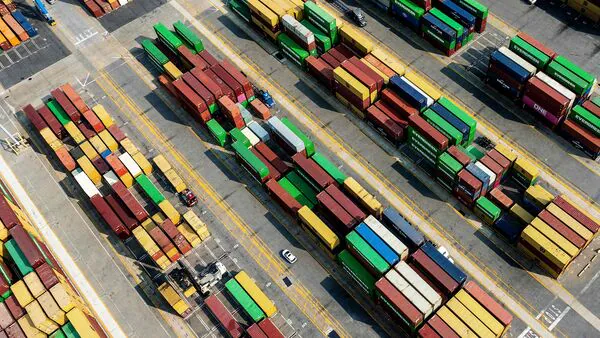India’s most populous state, Uttar Pradesh (UP), has long been a major contributor to the country’s export basket, with sectors such as textiles, handicrafts, jewellery, and leather products playing a pivotal role. Cities like Kanpur, Agra, Varanasi, and Moradabad are globally recognized hubs of craftsmanship and industrial output, driving both employment and foreign exchange earnings. However, recent tariff hikes by the United States—India’s single-largest export destination—pose a significant challenge to UP’s exporters.
In response, the Uttar Pradesh government and trade bodies are exploring new markets, diversifying export destinations, and encouraging innovation in product design and branding. This article takes an in-depth look at the impact of U.S. tariffs, the challenges and opportunities before UP’s exporters, and the state’s strategies for securing its export-led growth in a shifting global trade landscape.
The Significance of UP’s Export Economy
Uttar Pradesh holds a unique place in India’s export ecosystem. Key highlights include:
- Textiles & Handlooms: Varanasi’s Banarasi silk sarees and Bhadohi carpets are globally renowned. Together, they employ hundreds of thousands of artisans.
- Jewellery & Handicrafts: Moradabad, often called “Peetal Nagri” (brass city), is a leading exporter of brassware, handicrafts, and jewellery.
- Leather Products: Kanpur and Agra are known as India’s leather capitals, producing shoes, belts, bags, and garments for international brands.
- Agriculture-based Exports: Apart from manufactured goods, UP also exports sugar, rice, and processed foods.
According to state government data, UP’s exports crossed ₹1.75 lakh crore in FY23, contributing nearly 10% of India’s total exports. The U.S. has consistently been among the top destinations, accounting for nearly 20-25% of UP’s export earnings in key sectors like handicrafts, leather, and textiles.
The US Tariff Shock
The global trade order has witnessed growing protectionism in recent years, with the U.S. adopting tariffs and trade barriers under the pretext of protecting domestic industries. For UP’s exporters, this means:
- Higher Duties on Textiles & Apparel
Indian garments and textile products are now subjected to additional import duties, making them less competitive compared to products from countries with trade agreements with the U.S., such as Bangladesh and Vietnam. - Impact on Jewellery & Handicrafts
Indian jewellery faces higher tariffs, squeezing margins for exporters in Moradabad and other hubs. For small-scale artisans, this could mean reduced orders and declining wages. - Leather Industry Challenges
The U.S. has tightened tariff regimes and non-tariff barriers (like stricter compliance norms) on leather goods. This is a direct blow to Kanpur and Agra, where thousands of MSMEs depend on exports. - Loss of GSP (Generalized System of Preferences) Benefits
Earlier, several Indian goods enjoyed tariff exemptions under the U.S. GSP scheme. With its withdrawal, UP’s exporters face added costs.
Overall, U.S. tariffs threaten to reduce UP’s competitiveness, lower order volumes, and affect employment across these industries.
Why UP is Exploring New Markets
While the U.S. remains an important partner, over-reliance on a single market exposes exporters to risks. The tariff shock has pushed UP to diversify its trade strategy. Key reasons include:
- Market Dependence: Heavy dependence on the U.S. (nearly one-fourth of exports) creates vulnerability.
- Rising Competition: Countries like Vietnam, Bangladesh, and Turkey enjoy tariff advantages and are capturing U.S. market share.
- Changing Consumer Preferences: Growing demand for sustainable and ethically sourced products in Europe, Middle East, and East Asia opens new opportunities.
- Government Push: Both central and state governments are encouraging exporters to leverage free trade agreements (FTAs) with markets like the UAE, Australia, and the EU.
Target Markets for Diversification
UP is strategically eyeing several new destinations to counter U.S. tariff barriers:
1. European Union (EU)
The EU is a lucrative market for high-quality handicrafts, textiles, and leather goods. With ongoing India-EU trade talks, exporters are hopeful of tariff relaxations in the near future.
2. Middle East (UAE, Saudi Arabia, Qatar)
UP already exports jewellery, textiles, and processed foods to Gulf countries. The India-UAE Comprehensive Economic Partnership Agreement (CEPA) has opened duty-free access for many products.
3. Africa
Markets in South Africa, Kenya, and Nigeria are expanding rapidly. Affordable textiles, leather goods, and footwear from UP have significant potential here.
4. East & Southeast Asia
Japan, South Korea, and ASEAN nations are major importers of leather goods and textiles. India’s Act East policy is pushing exporters to tap this growing region.
5. Latin America
Brazil, Chile, and Mexico are new focus areas for Moradabad’s handicraft exporters.
By identifying and building long-term trade relations with these regions, UP aims to reduce dependency on the U.S.
Government Initiatives to Support Exporters
The UP government, in coordination with the central government, has rolled out measures to help exporters face global trade challenges.
- One District One Product (ODOP) Scheme
Each district in UP is being promoted for its unique craft/product—like Banarasi sarees (Varanasi), brassware (Moradabad), carpets (Bhadohi), and leather shoes (Agra). This has improved branding and visibility globally. - Export Promotion Councils
The state has strengthened export promotion councils to help MSMEs connect with international buyers. - Trade Fairs & Buyer-Seller Meets
Participation in global expos (Dubai Expo, Germany’s Ambiente Fair, etc.) is being encouraged for UP’s artisans and entrepreneurs. - Logistics & Infrastructure Support
Inland container depots (ICDs), cold storage facilities, and expressways are being developed to reduce logistics costs. The Jewar International Airport near Noida is expected to become a major logistics hub. - Financial Assistance & Skill Development
Exporters are being provided credit guarantees, interest subsidies, and training in global compliance standards.
Industry Voices: Challenges on the Ground
Exporters in UP acknowledge government support but highlight persistent challenges:
- High Compliance Costs: Meeting U.S. and EU quality standards requires heavy investments in technology.
- MSME Struggles: Small units lack resources to absorb tariff shocks and diversify quickly.
- Logistics Bottlenecks: Despite improvements, high transport costs remain a burden.
- Global Competition: Competing with low-cost producers like Bangladesh and Vietnam is difficult without tariff support.
Yet, many entrepreneurs see an opportunity in the crisis. A Kanpur-based leather exporter remarked:
“The U.S. tariffs are a setback, but we are now reaching out to the Middle East and Latin America, where demand is rising. It’s time to spread our risks.”
Opportunities in the Shift
While the U.S. tariffs are a challenge, they could also be a turning point for UP’s export ecosystem:
- Diversification for Long-Term Resilience
Moving away from over-dependence on the U.S. will create a more balanced and resilient export economy. - Push for Innovation & Branding
Exporters are investing in eco-friendly, sustainable production to meet global consumer expectations. - Leveraging FTAs
India’s recent FTAs with UAE and Australia, and ongoing talks with the EU and UK, open new tariff-free opportunities. - Digital Marketplaces
Platforms like Amazon Global and Flipkart Wholesale allow UP’s artisans to directly connect with international buyers, reducing dependency on middlemen.



